Abstract
All of 23 different preparations of formaldehyde-fixed and heat-killed bacteria induced the appearance of high levels of interferon (IFN) in cultures of human peripheral blood mononuclear leukocytes. Some bacteria induced peak IFN titers after 24 h of culture, whereas other bacteria showed maximal titers on culture days 2 to 3. The IFN displayed various properties. One type, which appeared early during the cultures, had characteristics of IFN-alpha, being resistant to pH 2 treatment but neutralized by antibodies to IFN-alpha. A second type, which appeared later, on culture days 2 to 3, resembled IFN-gamma in being sensitive to pH 2 treatment but resistant to anti-IFN-alpha antibodies. A third type, which appeared to be sensitive to both pH 2 and antibody treatment, was interpreted as atypical IFN-alpha. The application of cell fractionation procedures indicated that nonadherent, predominantly Fc receptor-bearing, non-T, non-B cells were producers of IFN-alpha as defined by its antigenic properties. They copurified approximately with cells carrying natural killer activity toward human erythroid leukemia K562 cells. Some bacteria apparently also stimulated T lymphocytes to produce material with properties of IFN-gamma.
Full text
PDF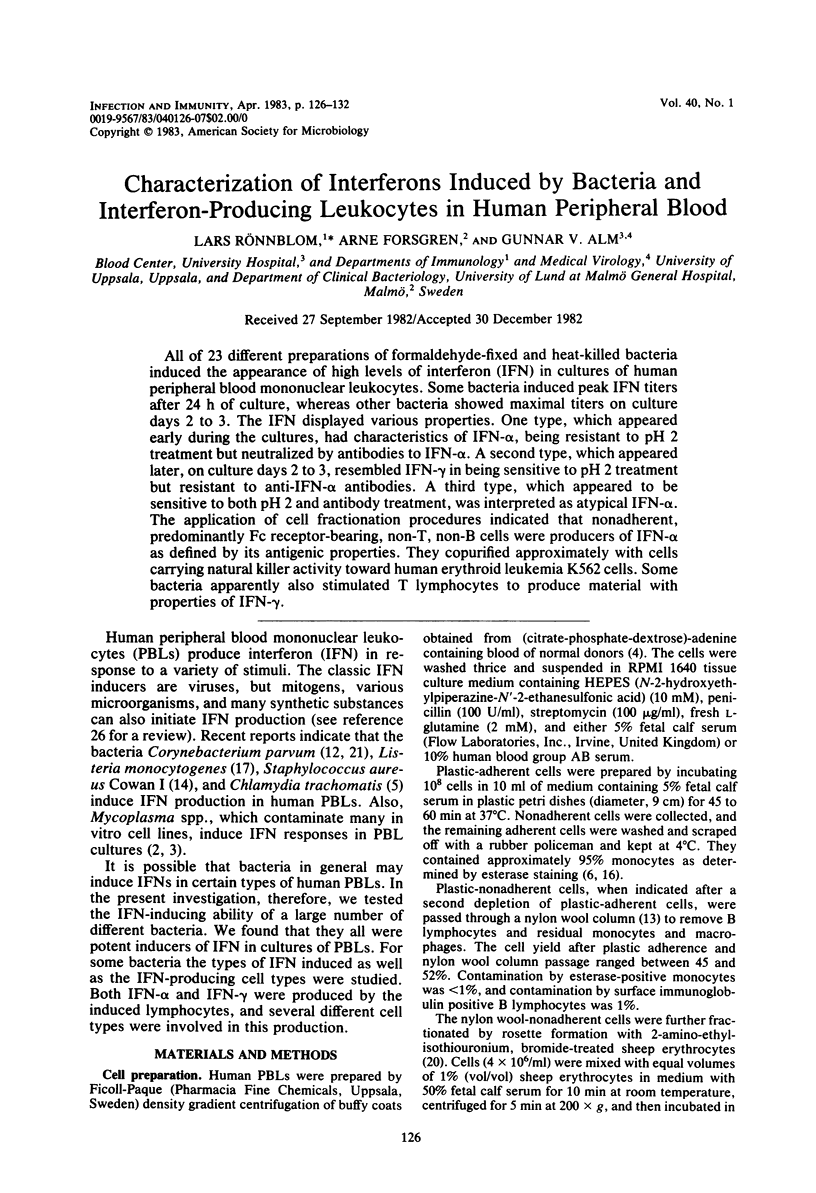
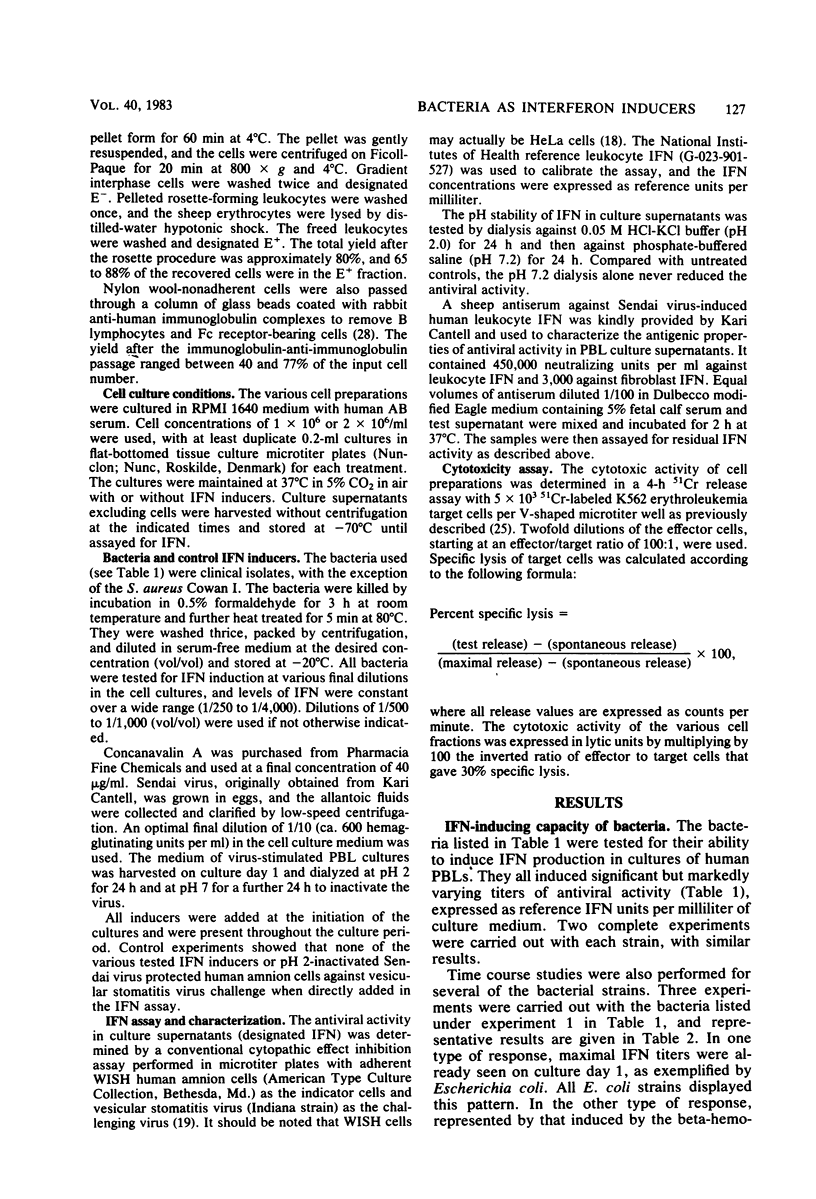
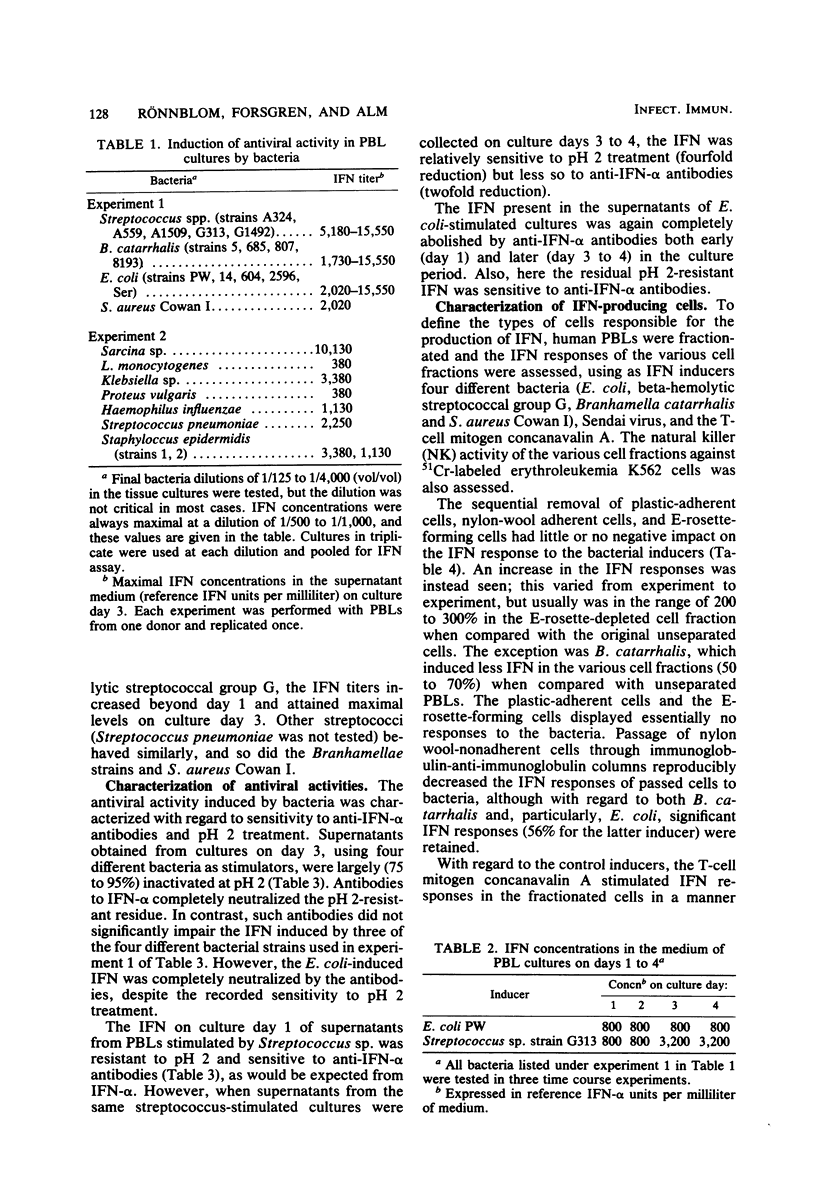
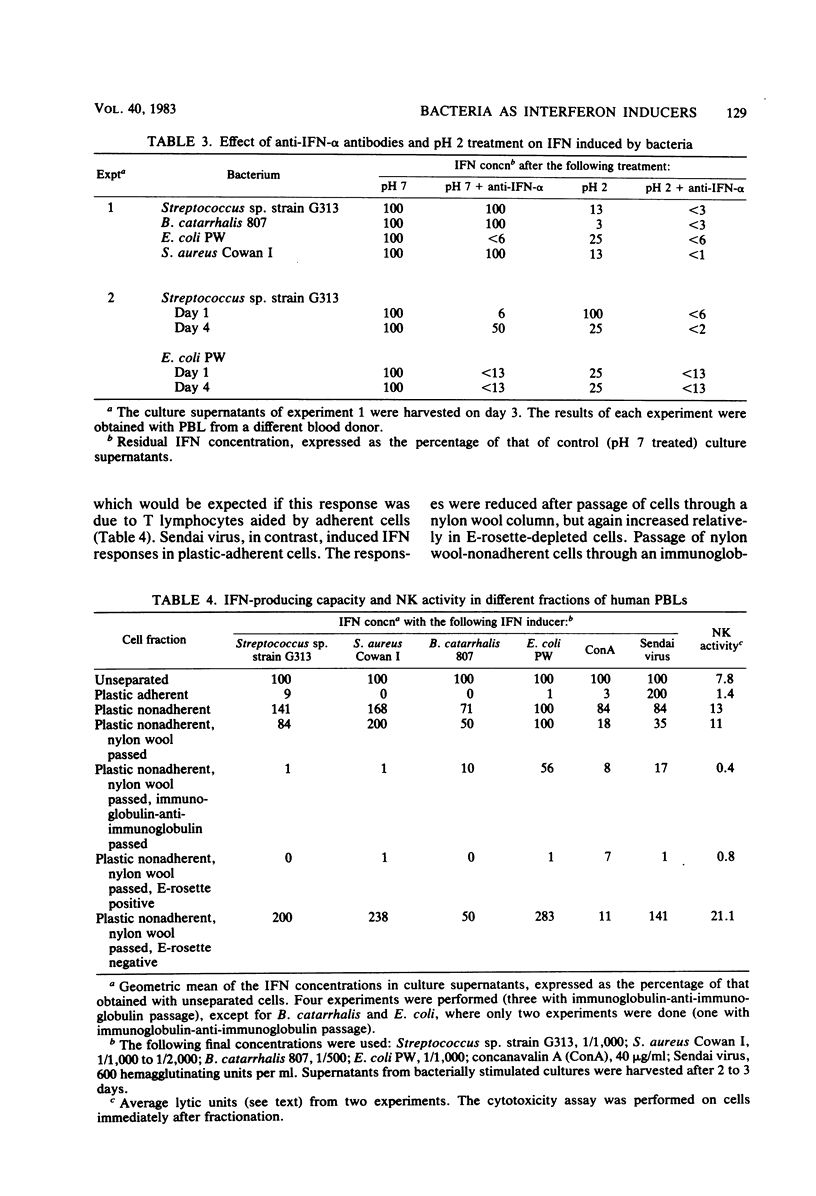
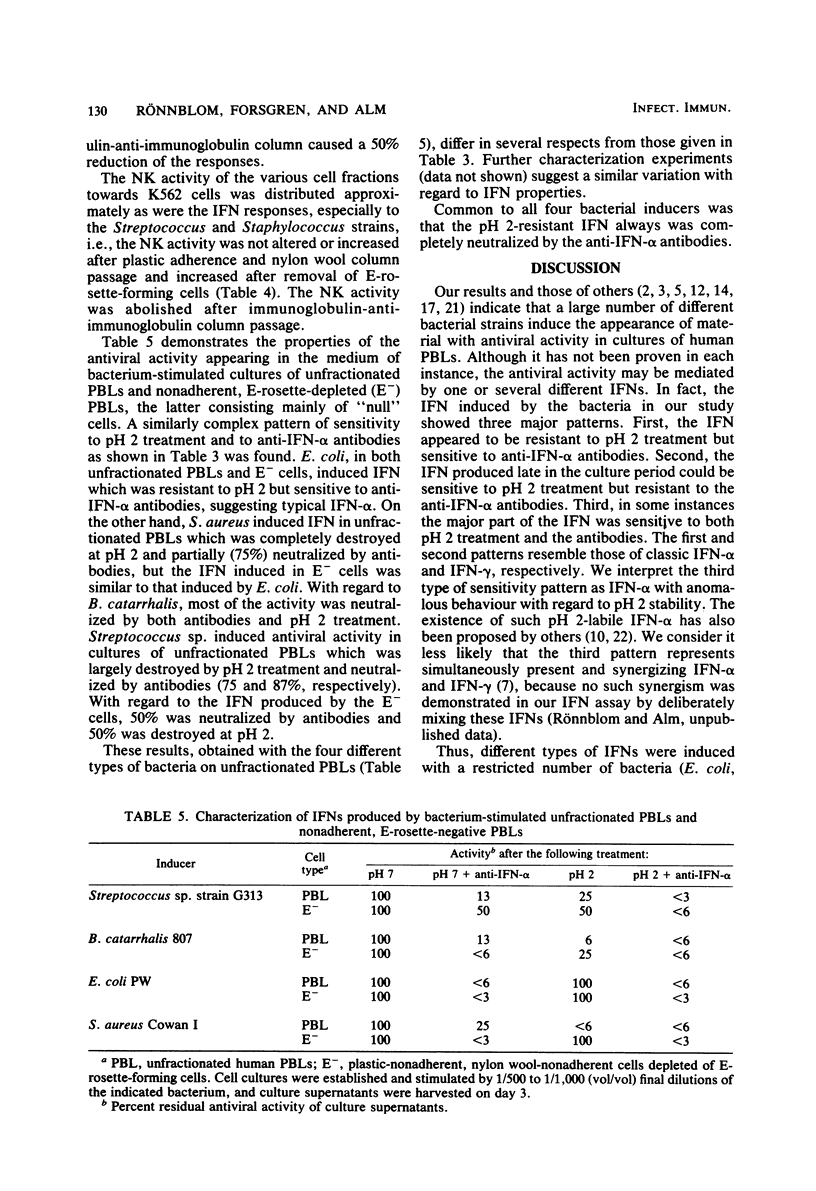
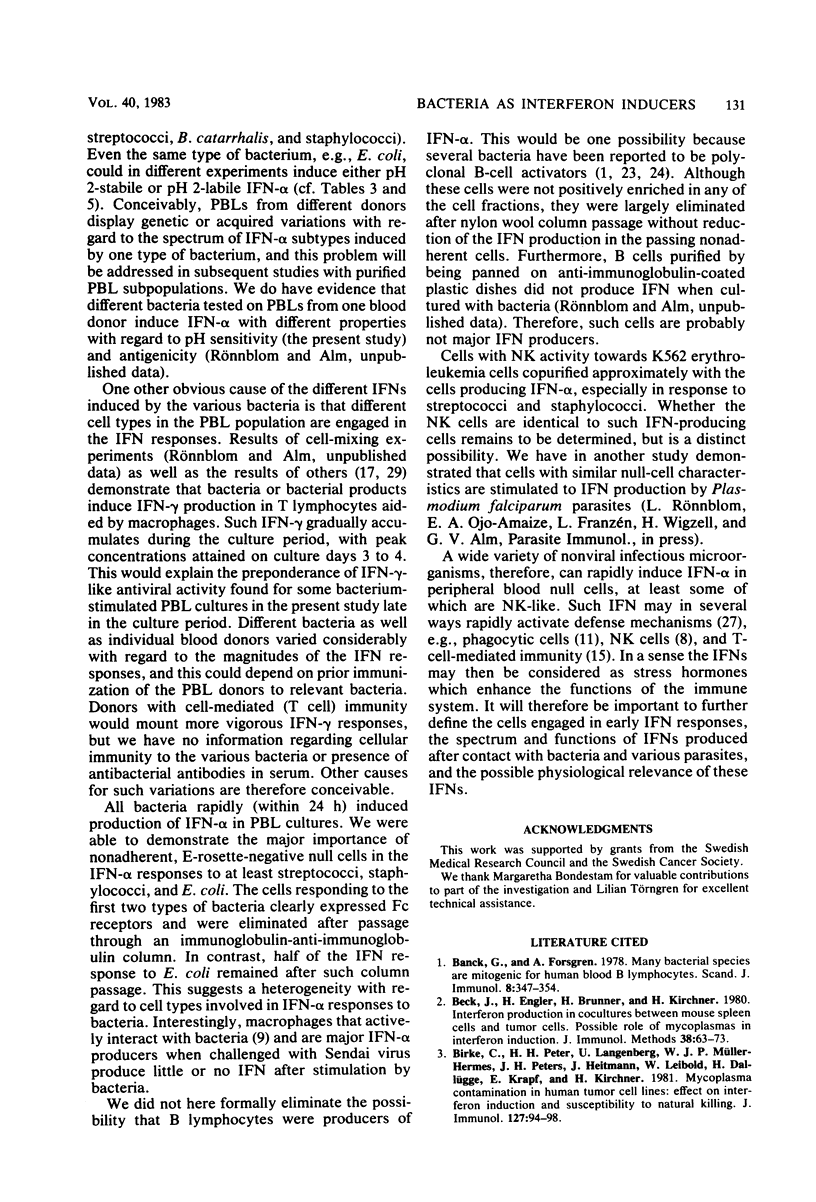
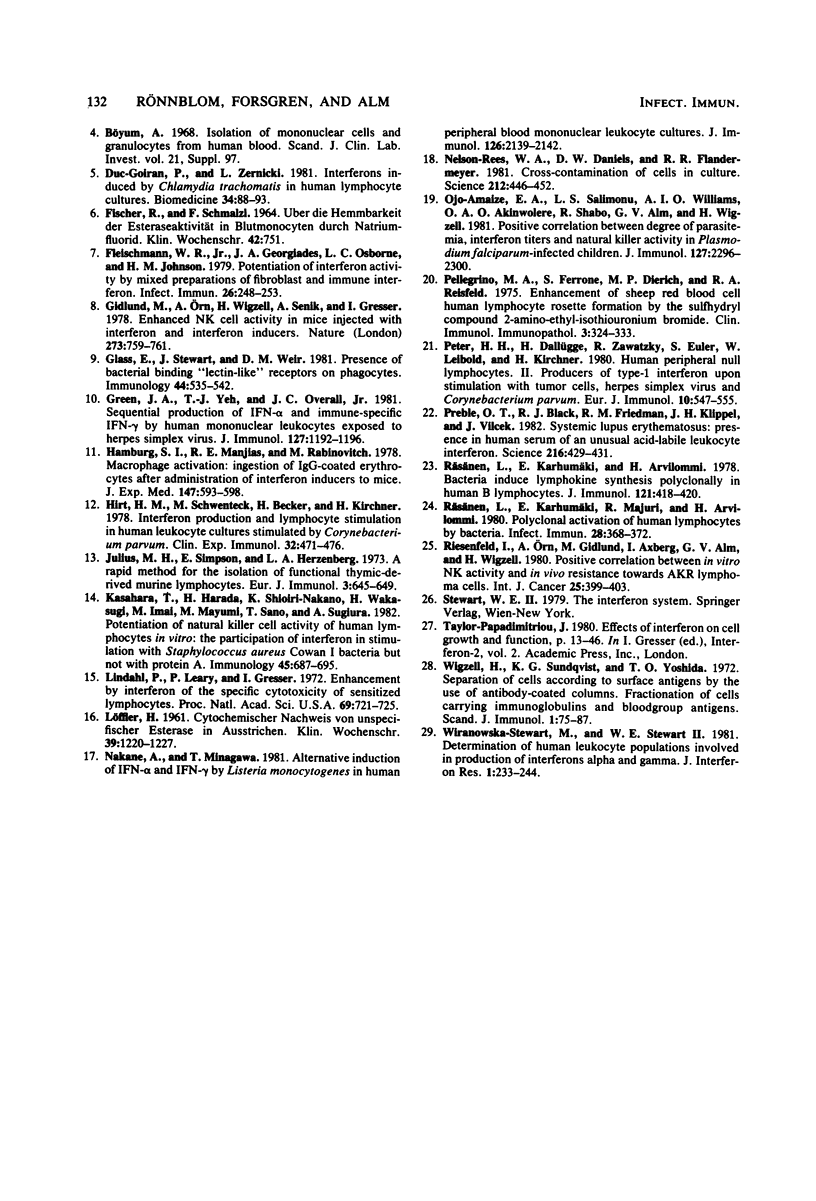
Selected References
These references are in PubMed. This may not be the complete list of references from this article.
- Banck G., Forsgren A. Many bacterial species are mitogenic for human blood B lymphocytes. Scand J Immunol. 1978;8(4):347–354. doi: 10.1111/j.1365-3083.1978.tb00528.x. [DOI] [PubMed] [Google Scholar]
- Beck J., Engler H., Brunner H., Kirchner H. Interferon production in cocultures between mouse spleen cells and tumor cells: possible role of mycoplasmas in interferon induction. J Immunol Methods. 1980;38(1-2):63–73. doi: 10.1016/0022-1759(80)90331-2. [DOI] [PubMed] [Google Scholar]
- Birke C., Peter H. H., Langenberg U., Müller-Hermes W. J., Peters J. H., Heitmann J., Leibold W., Dallügge H., Krapf E., Kirchner H. Mycoplasma contamination in human tumor cell lines: effect on interferon induction and susceptibility to natural killing. J Immunol. 1981 Jul;127(1):94–98. [PubMed] [Google Scholar]
- Duc-Goiran P., Zernicki L. Interferons induced by Chlamydia trachomatis in human lymphocyte cultures. Biomedicine. 1981 Sep;34(2):88–93. [PubMed] [Google Scholar]
- FISCHER R., SCHMALZL F. UBER DIE HEMMBARKEIT DER ESTERASEAKTIVITAET IN BLUTMONOCYTEN DURCH NATRIUMFLUORID. Klin Wochenschr. 1964 Aug 1;42:751–751. doi: 10.1007/BF01487816. [DOI] [PubMed] [Google Scholar]
- Fleischmann W. R., Jr, Georgiades J. A., Osborne L. C., Johnson H. M. Potentiation of interferon activity by mixed preparations of fibroblast and immune interferon. Infect Immun. 1979 Oct;26(1):248–253. doi: 10.1128/iai.26.1.248-253.1979. [DOI] [PMC free article] [PubMed] [Google Scholar]
- Gidlund M., Orn A., Wigzell H., Senik A., Gresser I. Enhanced NK cell activity in mice injected with interferon and interferon inducers. Nature. 1978 Jun 29;273(5665):759–761. doi: 10.1038/273759a0. [DOI] [PubMed] [Google Scholar]
- Green J. A., Yeh T. J., Overall J. C., Jr Sequential production of IFN-alpha and immune-specific IFN-gamma by human mononuclear leukocytes exposed to herpes simplex virus. J Immunol. 1981 Sep;127(3):1192–1196. [PubMed] [Google Scholar]
- Hamburg S. I., Manejias R. E., Rabinovitch M. Macrophage activation: increased ingestion of IgG-coated erythrocytes after administration of interferon inducers to mice. J Exp Med. 1978 Feb 1;147(2):593–598. doi: 10.1084/jem.147.2.593. [DOI] [PMC free article] [PubMed] [Google Scholar]
- Hirt H. M., Schwenteck M., Becker H., Kirchner H. Interferon production and lymphocyte stimulation in human leucocyte cultures stimulated by Corynebacterium parvum. Clin Exp Immunol. 1978 Jun;32(3):471–476. [PMC free article] [PubMed] [Google Scholar]
- Julius M. H., Simpson E., Herzenberg L. A. A rapid method for the isolation of functional thymus-derived murine lymphocytes. Eur J Immunol. 1973 Oct;3(10):645–649. doi: 10.1002/eji.1830031011. [DOI] [PubMed] [Google Scholar]
- Kasahara T., Harada H., Shioiri-Nakano K., Wakasugi H., Imai M., Mayumi M., Sano T., Sugiura A. Potentiation of natural killer cell activity of human lymphocytes in vitro: the participation of interferon in stimulation with Staphylococcus aureus Cowan I bacteria but not with protein A. Immunology. 1982 Apr;45(4):687–695. [PMC free article] [PubMed] [Google Scholar]
- Kodama K., Yoshida T., Shibiya T., Kurashige S., Mitsuhashi S. Induction of IgM memory with RNA from the spleens of immunized mice. Immunology. 1981 Nov;44(3):535–542. [PMC free article] [PubMed] [Google Scholar]
- Lindahl P., Leary P., Gresser I. Enhancement by interferon of the specific cytotoxicity of sensitized lymphocytes. Proc Natl Acad Sci U S A. 1972 Mar;69(3):721–725. doi: 10.1073/pnas.69.3.721. [DOI] [PMC free article] [PubMed] [Google Scholar]
- Nakane A., Minagawa T. Alternative induction of IFN-alpha and IFN-gamma by Listeria monocytogenes in human peripheral blood mononuclear leukocyte cultures. J Immunol. 1981 Jun;126(6):2139–2142. [PubMed] [Google Scholar]
- Nelson-Rees W. A., Daniels D. W., Flandermeyer R. R. Cross-contamination of cells in culture. Science. 1981 Apr 24;212(4493):446–452. doi: 10.1126/science.6451928. [DOI] [PubMed] [Google Scholar]
- Ojo-Amaize E. A., Salimonu L. S., Williams A. I., Akinwolere O. A., Shabo R., Alm G. V., Wigzell H. Positive correlation between degree of parasitemia, interferon titers, and natural killer cell activity in Plasmodium falciparum-infected children. J Immunol. 1981 Dec;127(6):2296–2300. [PubMed] [Google Scholar]
- Pellegrino M. A., Ferrone S., Dierich M. P., Reisfeld R. A. Enhancement of sheep red blood cell human lymphocyte rosette formation by the sulfhydryl compound 2-amino ethylisothiouronium bromide. Clin Immunol Immunopathol. 1975 Jan;3(3):324–333. doi: 10.1016/0090-1229(75)90019-7. [DOI] [PubMed] [Google Scholar]
- Peter H. H., Dallügge H., Zawatzky R., Euler S., Leibold W., Kirchner H. Human peripheral null lymphocytes. II. Producers of type-1 interferon upon stimulation with tumor cells, Herpes simplex virus and Corynebacterium parvum. Eur J Immunol. 1980 Jul;10(7):547–555. doi: 10.1002/eji.1830100712. [DOI] [PubMed] [Google Scholar]
- Preble O. T., Black R. J., Friedman R. M., Klippel J. H., Vilcek J. Systemic lupus erythematosus: presence in human serum of an unusual acid-labile leukocyte interferon. Science. 1982 Apr 23;216(4544):429–431. doi: 10.1126/science.6176024. [DOI] [PubMed] [Google Scholar]
- Riesenfeld I., Orn A., Gidlund M., Axberg I., Alm G. V., Wigzell H. Positive correlation between in vitro NK activity and in vivo resistance towards AKR lymphoma cells. Int J Cancer. 1980 Mar 15;25(3):399–403. doi: 10.1002/ijc.2910250315. [DOI] [PubMed] [Google Scholar]
- Räsänen L., Karhumäki E., Arvilommi H. Bacteria induce lymphokine synthesis polyclonally in human B lymphocytes. J Immunol. 1978 Aug;121(2):418–420. [PubMed] [Google Scholar]
- Räsänen L., Karhumäki E., Majuri R., Arvilommi H. Polyclonal activation of human lymphocytes by bacteria. Infect Immun. 1980 May;28(2):368–372. doi: 10.1128/iai.28.2.368-372.1980. [DOI] [PMC free article] [PubMed] [Google Scholar]
- Wigzell H., Sundqvist K. G., Yoshida T. O. Separation of cells according to surface antigens by the use of antibody-coated columns. Fractionation of cells carrying immunoglobulins and blood group antigen. Scand J Immunol. 1972;1(1):75–87. doi: 10.1111/j.1365-3083.1972.tb03737.x. [DOI] [PubMed] [Google Scholar]
- Wiranowska-Stewart M., Stewart W. E., 2nd Determination of human leukocyte populations involved in production of interferons alpha and gamma. J Interferon Res. 1981 Feb;1(2):233–244. doi: 10.1089/jir.1981.1.233. [DOI] [PubMed] [Google Scholar]


